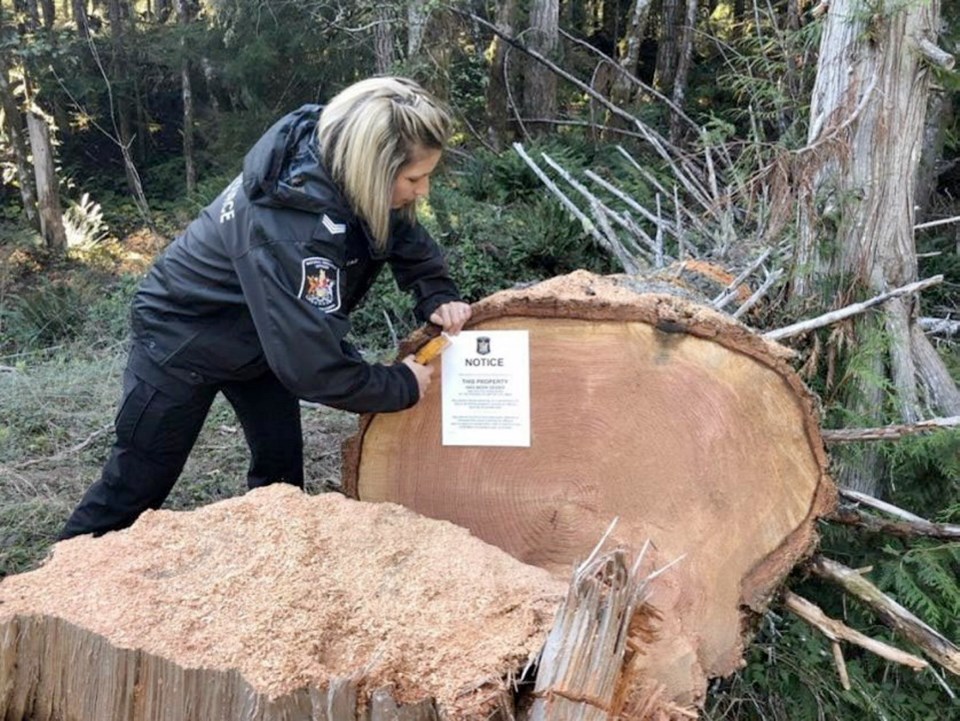Magnificent trees that are hundreds of years old are being poached by timber thieves, sometimes just to turn a quick buck by reducing old-growth Douglas fir to firewood.
Timber poachers are becoming more of a problem on Vancouver Island, where they enter Crown land and chop down old-growth trees under the cover of darkness.
And B.C.’s natural-resource officers are now asking for the public’s help in their hunt for poachers, reporting any suspicious activities they witness while hiking or riding on Crown land.
“We’ve seen a real surge of blatant timber theft across [Vancouver Island] over the last couple of years,” said Luke Clarke, a natural resource enforcement officer with the Forests, Lands, Natural Resource Operations and Rural Development Ministry.
He said the thieves are targeting commercial-grade timber and cutting down the trees, sometimes unsafely, to sell it to unscrupulous mills or unsuspecting individuals.
“They see a product that’s valuable and which belongs to the public and they’re taking it,” he said.
He said he and his fellow officers on patrol are seeing more and more evidence of illegal harvesting of trees, especially Douglas fir, red cedar and bigleaf maple. “They’re working in groups,” Clarke said. “They’re cutting down trees and then coming to collect them later.”
The thieves often cover telltale freshly cut stumps and sawdust with moss to cover their tracks.
Clarke said legitimate loggers practise forestry methods that leave old-growth trees behind in strategic locations, to provide a buffer next to bodies of water and to maintain an ecosystem for wildlife and other plant growth, only to have poachers fell them.
He said while working as a park ranger years ago, he came across the remains of an old-growth bigleaf maple on an ecological reserve on the east coast of Vancouver Island.
“It was a big, perfect specimen and to see that was so offensive to me,” Clarke said. “Those trees are priceless.”
He said some thieves are simply trying to turn a fast buck selling firewood.
Others are looking for large boards popular for custom-made dining room tables or hoping to capitalize on rising prices for certain woods by supplying mills. Bigleaf maple is popular for making guitars and other musical instruments.
Clarke said natural-resource officers patrol Crown lands around the clock looking for timber poachers, along with their many other duties, but can’t be everywhere at once.
“We rely on members of the public to be our eyes and ears … when they’re recreating and see anything suspicious, if they see someone harvesting a tree that shouldn’t be harvested.”
He urged members of the public to call the tips hotline, at 877-952-7277, or #7277 on most cellphone networks.
Clarke said it’s also up to the public to ensure the firewood or other wood they’re buying comes with a load slip that contains all the information to show where it was grown and harvested and the name of the seller, or risk a fine for buying poached wood.
He said that it’s illegal to collect wood or timber unless you have obtained a permit to harvest wood on Crown land.
The compliance and enforcement branch is investigating a number of timber-poaching cases at the moment, Clarke said.
It works with the RCMP to build a case to charge poachers by using modern technological forensic techniques, such as matching growth rings and saw marks, to trace timber to its source.
“We treat timber theft like any other criminal act,” he said.
Figures on charges or convictions for poaching weren’t immediately available from the Forests Ministry.



